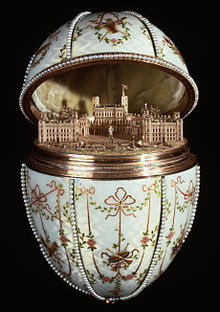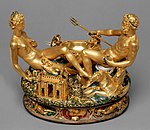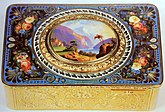Objet d'art

Inart history,the French termobjet d'art(/ˌɒbʒeɪˈdɑːr/;French pronunciation:[ɔbʒɛdaʁ]) describes an ornamentalwork of art,and the termobjets d’artdescribes a range of works of art, usually small and three-dimensional, made of high-quality materials, and a finely-rendered finish that emphasises the aesthetics of the artefact.[1]Artists create and produceobjets d’artin the fields of thedecorative artsandmetalwork,porcelainandvitreous enamel;figurines,plaquettes,andengraved gems;ivory carvingsand semi-precioushardstone carvings;tapestries,antiques,andantiquities;and books with finebookbinding.
TheNational Maritime Museum,Greenwich,London, describes their accumulated artworks as a: "collection ofobjets d’art[which] comprises over 800 objects. These are mostly small, decorative art items that fall outside the scope of the Museum’s ceramic, plate, textiles and glass collections. "The artwork collection also includes metal curtain ties, a lacqueredpapier-machétray, tobacco boxes,cigarette cases,découpage(cut-paper items),portrait miniatures,a gilt-brass clock finial, plaques, statuettes, plaquettes, ahorse brass,a metal pipe tamper, a smallglass painting,et cetera.[2]
Objet de vertu
[edit]
Theobjet de vertu,whereinvertusuggests rich materials and a higher standard of refined manufacture and finish; the classification usually excludes objects made for realising a practical function. As works of art,objets de vertureflect the rarified aesthetic andconspicuous consumptioncharacteristic of an aristocratic court — of the late-medievalBurgundian dukes,theMughal emperors,or Ming China — such as theLycurgus Cup,which is acage cupmade ofRoman glass;the Byzantine agate "Rubens vase"; the Roman glass "Portland Vase",and onyx and chalcedonycameo carvings,whilst the pre–World War I production ofobjets d'artfeaturedFabergé eggsmade ofprecious metalsand decorated withgemstones.
A comparable term that appears in 18th- and 19th-century French sale catalogs,[3]though now less used, isobjets de curiosité,"objects of curiosity",[4]now devolved into the less-valuedcurio.Elaborate late Renaissance display pieces in silver that incorporate organic elements such asostrich eggs,nuts of thecoco de merand sea-shells are grouped in a volume, published in 1991, as "The Curiousities" in the catalogues of theWaddesdon Bequestat theBritish Museum.[5]
Images
[edit]-
Anobjet de vertuby excellence,Fabergé's"Memory of Azov Egg"(1891), contains a ship model wrought of gold.
-
TheRubens Vase,carved in high relief from a single piece ofagate,4th century
-
InBenvenuto Cellini's "table salt cellar",extravagant invention and richness of materials overwhelm any practical use.
-
A Swisssinging bird boxwith a bucolic lake scene on the lid,c. 1825,another example of anobjet de vertu
See also
[edit]References
[edit]- ^The New Shorter Oxford English Dictionary(1993) Lesley Brown, Ed. p. 1,965.
- ^objets d'artArchived2012-09-04 at theWayback Machine,National Maritime Museum
- ^Such as theCatalogue raisonné des différens objets de curiosité dans les sciences et arts, qui composoient le cabinet de feu Mr..Paris, 1775; in 1916 A. Tuete edited theInventaire des laques anciennes et des objets de curiosité deMarie-Antoinette:confiés àDaguerreet Lignereux, marchands bijoutiers, le 10 octobre 1789.
- ^Maurice Rheims'La vie étrange des objets(1959) is subtitledhistoire de la curiosité.
- ^Tait, Hugh,A Catalogue of the Waddesdon Bequest in the British Museum,several volumes, British Museum. Volumes: I,The Jewels,1986; IIThe Silver Plate,1988; IIIThe Curiosities,1991.




